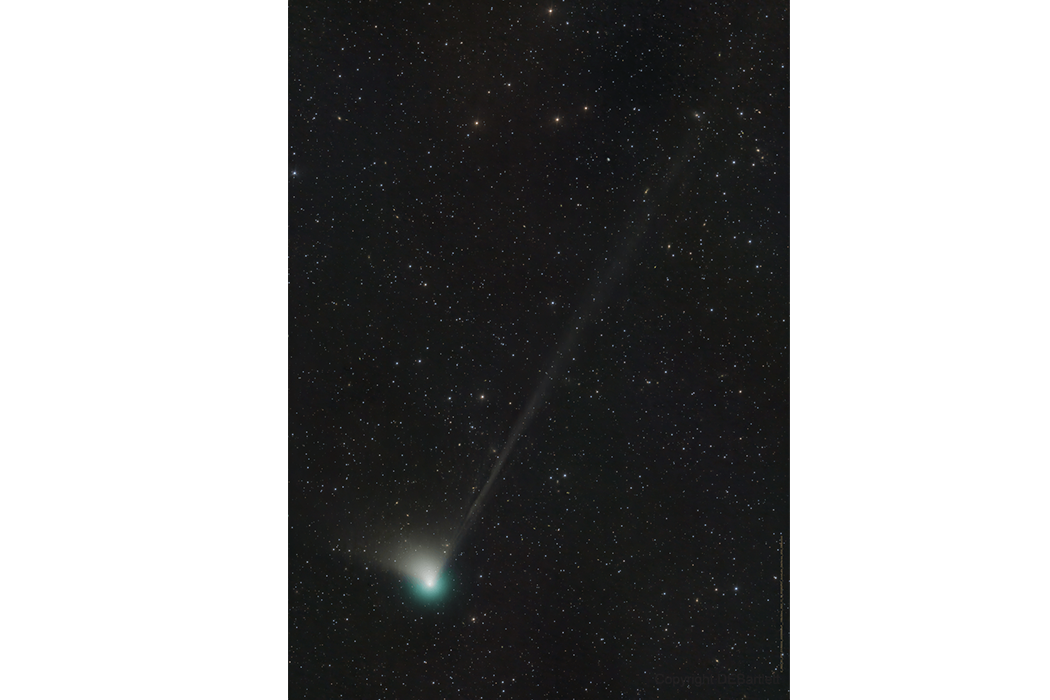
This February 1 at 17:54 UTC, a newly-discovered comet hailing from the outer reaches of the solar system, called C/2022 E3 ZTF or “Comet E3” for short, will pass by Earth for the first time in over 50,000 years. Observations from Unistellar/SETI citizen astronomers suggest that as the comet flies within 27 million miles of our planet, it could become visible to the naked eye. This chance to see Comet E3 may very well be the last for us Earthlings, as its trajectory shows it on course to leave our solar system altogether.
Comets like Comet E3 are small Solar System bodies made of different ices and dust that originate in the faraway Oort cloud, a region of the Solar System beyond Neptune. Due to the frigid temperatures of the Oort cloud, these icy objects act as time capsules from the Solar System’s earliest days since their water, dust and rocks have remained frozen for billions of years. As Comet E3 nears the Sun and Earth, these ancient materials get exposed in a spectacular fashion.
Two major factors, the distance of the comet from the Sun and Earth, determine the type of cometary activity that we see. As a comet nears the Sun and heats up, its ices sublimate, or turn from a solid into a gas. This sublimation drags dust from the comet’s surface to create its striking bright dust tail as well as its coma, which appears as a gas and dust cloud around the comet. The trademark eerie green glow of the coma that you see in the Unistellar/SETI citizen astronomer observations below is caused by the presence of diatomic carbon and/or cyanogen. The ion tail, which is a stream of charged particles expelled from the coma due to the Sun’s radiation, is also visible in these observations. This part of the tail always points away from the Sun, and you can spot it to the right of the bright, fanned dust tail. Luckily for us, these cosmic features will continue to brighten as the comet speeds towards the Earth.

Although Comet E3 already made its close passage by the Sun on January 12, it is still getting brighter as perigee approaches, the point in its orbit when it is closest to our planet. As such, Unistellar/SETI citizen astronomers have been monitoring Comet E3 since early 2022 after its discovery in March. With the crucial data they have gathered, SETI researchers have been able to track its changing brightness and make predictions regarding its appearance as it nears the Earth. “Observing these changes is what makes comets so interesting, because it makes these unpredictable bodies a little less mysterious. We know now that we will only need binoculars to see the comet on Feb 1. In some dark areas, perhaps we won’t need any tools at all!” says SETI Institute astronomer Dr. Ariel Graykowski, who leads the Unistellar Cometary Activity program.

Although they make for fascinating spectacles, comets are not just a pretty sight in the night sky – astronomers believe that Earth was bombarded by comets in its early days, and since many comets have been found to carry organic material, they could be the key to understanding the development of life on Earth. Comets also contain water ice in their rocky bodies, and scientists think that a substantial portion of Earth’s water may have originated from cometary collisions. This means that these small-but-mighty comets could have shaped life as we know it, making them particularly interesting for SETI Institute Senior Planetary Astronomer and Unistellar Chief Science Officer, Dr. Franck Marchis: “Our goal is to monitor continuously the dark sky thanks to the contribution of citizen astronomers worldwide. Because there is always a starry night in the Unistellar network, we hope to catch any anomalous activity from this comet as it starts, like ejecta, or something more dramatic like the disintegration of the comet. We don’t know what will happen to Comet E3 - comets are like cats, they are unpredictable.”
To observe Comet E3 before it is too late, merely point your telescope, binoculars, or eyes to the sky. By the time it reaches perigee on February 1st, this comet will only be visible to the Northern hemisphere, but it will be circumpolar and therefore visible all night long. So catch your observations of this once-in-a-lifetime comet before it leaves our realm for good! You can learn more about how to observe Comet E3 with the Unistellar Network here.






